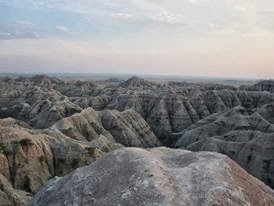Badlands
National Park in South Dakota consists of approximately 243,000 acres
of land. The Lakota people originally called the landforms that comprise
the region “mako sika,” or “land bad.” This area has extreme
temperature fluctuations and little water, so the name is certainly
appropriate.
The Badlands was designated a national park in 1978. Prior to this, and as of 1939, the area was considered a national monument. This means that the area has significant items of scientific, historic, or prehistoric value. A national monument designation usually protects only one significant resource. The region does, in fact, possess rich fossil life; preserved organisms from the Oligocene epoch (some 23 to 35 million years old) are found here. With a national park designation, on the other hand, a larger area and many other significant features found within it are preserved, such as the largest protected grasslands in the United States, and the magnificent buttes and sharp peaks that make up the landscape of the region. National park areas are set aside for public use for natural beauty and scenery; I can tell you firsthand that this area certainly does have breathtaking features, since I hiked the hills of the Badlands this past August.
As a lover of fossils, I am glad this region has been protected so that we can learn more about the life that came before us. As a lover of beautiful landscapes, I am also happy to know that I can come back here in the future and take it all in again.
The Badlands was designated a national park in 1978. Prior to this, and as of 1939, the area was considered a national monument. This means that the area has significant items of scientific, historic, or prehistoric value. A national monument designation usually protects only one significant resource. The region does, in fact, possess rich fossil life; preserved organisms from the Oligocene epoch (some 23 to 35 million years old) are found here. With a national park designation, on the other hand, a larger area and many other significant features found within it are preserved, such as the largest protected grasslands in the United States, and the magnificent buttes and sharp peaks that make up the landscape of the region. National park areas are set aside for public use for natural beauty and scenery; I can tell you firsthand that this area certainly does have breathtaking features, since I hiked the hills of the Badlands this past August.
As a lover of fossils, I am glad this region has been protected so that we can learn more about the life that came before us. As a lover of beautiful landscapes, I am also happy to know that I can come back here in the future and take it all in again.
I took this photo while on a hike in Badlands National Park in August 2013. I hope you enjoy it!
For more on the geologic history of this region and other badlands topography, please see:
https://www.facebook.com/
References:
http://www.npca.org/parks/
http://www.nps.gov/
http://www.nps.gov/cong/
http://www.nps.gov/badl/


No comments:
Post a Comment